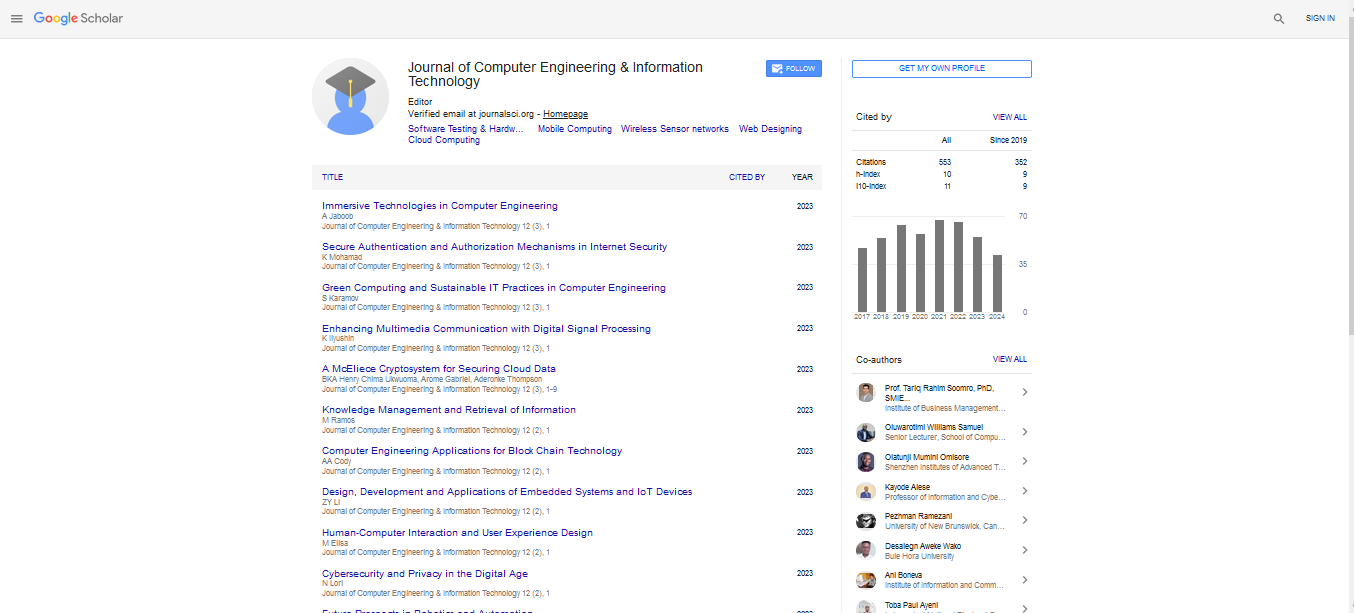Editorial, Jceit Vol: 14 Issue: 1
API Management: The Backbone of Modern Digital Integration
Jimin Jung*
Department of Computer Engineering, Inha University, Inha-ro, Michuhol-gu, Republic of Korea
- *Corresponding Author:
- Jimin Jung
Department of Computer Engineering, Inha University, Inha-ro, Michuhol-gu, Republic of Korea
E-mail: jung@jimin.kr
Received: 01-Jan-2025, Manuscript No. jceit-25-169302; Editor assigned: 4-Jan-2025, Pre-QC No. jceit-25-169302 (PQ); Reviewed: 20-Jan-2025, QC No jceit-25-169302; Revised: 27-Jan-2025, Manuscript No. jceit-25-169302 (R); Published: 31-Jan-2025, DOI: 10.4172/2324-9307.1000327
Citation: Jimin J (2025) API Management: The Backbone of Modern Digital Integration. J Comput Eng Inf Technol 14: 327
Abstract
Introduction
In today’s hyperconnected digital landscape, Application Programming Interfaces (APIs) have become the vital glue binding together disparate software systems, cloud services, and devices. From powering mobile apps to enabling seamless integration between cloud platforms, APIs are fundamental to digital innovation and business agility.
However, as organizations scale their API ecosystems, managing these interfaces efficiently becomes increasingly complex. This is where API Management steps in [1] — a comprehensive approach to designing, publishing, securing, monitoring, and analyzing APIs. Effective API management not only accelerates development but also safeguards sensitive data, ensures reliability, and drives monetization opportunities.
In this editorial, we explore why API management is critical in the digital era, the core components of successful API management, challenges businesses face, and the future outlook of this essential discipline.
Why API Management Matters
APIs expose backend services to internal developers, external partners, and customers, enabling innovation and collaboration across ecosystems. But without governance, APIs can become a security liability, a source of performance issues, and an operational nightmare.
API management platforms provide a unified control plane that addresses these risks by offering:
Security and Access Control: Enforcing authentication, authorization, rate limiting, and threat protection to prevent abuse.
Traffic Management: Handling API request routing, load balancing, and throttling to maintain performance and availability [2].
Developer Experience: Providing self-service portals, documentation, and sandbox environments to accelerate adoption.
Analytics and Monitoring: Delivering real-time insights into API usage, latency, and errors to optimize performance.
Lifecycle Management: Facilitating versioning, deprecation, and governance policies to ensure consistency.
By adopting API management, organizations gain visibility and control over their APIs, reducing risks while maximizing the business value of their digital assets.
Core Components of API Management
A robust API management solution typically includes:
API Gateway: The entry point that routes API calls, enforces security policies [3], and manages traffic.
Developer Portal: A hub for API consumers with documentation, testing tools, and onboarding resources.
Analytics Engine: Provides metrics and reports to track API health, usage patterns, and potential bottlenecks.
Policy Enforcement: Implements security measures like OAuth, JWT validation, and IP whitelisting.
Lifecycle Tools: Manages API creation, version control, publishing, and retirement.
Together, these components enable organizations to treat APIs as products, fostering innovation while maintaining operational excellence.
Challenges in API Management
Despite its benefits, API management introduces challenges, such as:
Security Threats: APIs are prime targets for attacks like injection, DDoS, and data breaches. Keeping pace with evolving threats requires constant vigilance [4].
Complexity at Scale: Large enterprises may manage thousands of APIs, demanding sophisticated tools for discovery, cataloging, and governance.
Integration Difficulties: Legacy systems and heterogeneous environments can complicate API deployment and management.
Performance Overhead: Improperly configured API gateways can introduce latency or bottlenecks.
Developer Engagement: Success depends on effectively supporting and engaging the developer community.
Addressing these challenges requires a strategic approach, combining technology, processes, and culture.
The Future of API Management
As digital ecosystems mature, API management is evolving with new trends:
API-First Design: Organizations are adopting API-first strategies where APIs are central to product development.
Microservices and Serverless: API management adapts to more [5] granular and ephemeral workloads, supporting modern architectures.
AI-Driven Analytics: Machine learning helps predict usage trends, detect anomalies, and automate security enforcement.
Hybrid and Multi-Cloud Support: Managing APIs across diverse cloud environments demands flexible, cloud-native platforms.
Monetization Models: APIs increasingly become revenue streams, requiring integrated billing and usage tracking.
API management will remain critical as businesses accelerate their digital transformation journeys.
Conclusion
APIs are the connective tissue of modern digital business, enabling agility, innovation, and ecosystem collaboration. But their potential can only be fully realized through effective API management. By securing, governing, and optimizing APIs, organizations transform them from technical interfaces into strategic assets.
Investing in comprehensive API management is no longer optional—it is essential for companies aiming to compete and thrive in a fast-paced digital economy. Those who master API management will unlock new opportunities, deliver superior digital experiences, and build resilient, scalable systems ready for the future.
References
- Gartner (2023) Magic Quadrant for Full Life Cycle API Management.
- Postman (2024) The State of API Integration 2024 Report.
- Apigee (2023) API Management Best Practices.
- MuleSoft (2023) What is API Management?
- ProgrammableWeb (2024) API Security Challenges and Trends.
Indexed at, Google Scholar, Crossref
Indexed at, Google Scholar, Crossref
Indexed at, Google Scholar, Crossref
Indexed at, Google Scholar, Crossref
 Spanish
Spanish  Chinese
Chinese  Russian
Russian  German
German  French
French  Japanese
Japanese  Portuguese
Portuguese  Hindi
Hindi 